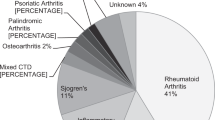Abstract
To evaluate the role of previously reported risk factors on developing retinopathy in patients treated with chloroquine (CQ) and hydroxychloroquine (HCQ). Ophthalmologic examination, visual field testing, and spectral domain-optical coherence tomography were performed in 31 patients treated with CQ and HCQ. Toxicity diagnosis was proven by electrophysiological assessment. The risk factors reported by the American Academy of the Ophthalmology (AAO) were compared between patients with (n = 5) and without toxicity (n = 26) findings. Risk score was calculated for each patient. CQ daily overdose per actual body weight was significantly higher in affected patients. There was no statistically significant difference between groups concerning risk score, estimated cumulative dose of CQ, daily dose of HCQ and CQ per lean body weight, daily overdose of CQ per lean body weight and actual body weight (>3 mg/kg). The cumulative dose of HCQ was significantly higher in non-affected patients. The risk factors reported by the AAO might not be applicable to all CQ- and HCQ-treated patients. Different risk factors not yet reported may play a role in the development of CQ and HCQ retinopathy.


Similar content being viewed by others
References
Bernstein HN (1991) Ocular safety of hydroxychloroquine. Ann Ophthalmol 23(8):292–296
Mavrikakis I, Sfikakis PP, Mavrikakis E et al (2003) The incidence of irreversible retinal toxicity in patients treated with hydroxychloroquine: a reappraisal. Ophthalmology 110(7):1321–1326
Marmor MF, Carr RE, Easterbrook M, Farjo AA, Mieler WF (2002) American Academy of Ophthalmology. Recommendations on screening for chloroquine and hydroxychloroquine retinopathy: a report by the American Academy of Ophthalmology. Ophthalmology 109(7):1377–1382
Lyons JS, Severns ML (2009) Using multifocal ERG ring ratios to detect and follow plaquenil retinal toxicity: a review: review of mfERG ring ratios in plaquenil toxicity. Doc Ophthalmol 118(1):29–36
Bergholz R, Schroeter J, Rüther K (2010) Evaluation of risk factors for retinal damage due to chloroquine and hydroxychloroquine. Br J Ophthalmol 94(12):1637–1642
Shichiri M, Kono N, Shimanaka Y et al (2012) A novel role for α-tocopherol transfer protein (α-TTP) in protecting against chloroquine toxicity. J Biol Chem 287(4):2926–2934
Shroyer NF, Lewis RA, Lupski JR (2001) Analysis of the ABCR (ABCA4) gene in 4-aminoquinoline retinopathy: is retinal toxicity by chloroquine and hydroxychloroquine related to Stargardt disease? Am J Ophthalmol 131(6):761–766
Marmor MF, Kellner U, Lai TY, Lyons JS, Mieler WF (2011) American Academy of Ophthalmology. Revised recommendations on screening for chloroquine and hydroxychloroquine retinopathy. Ophthalmology 118(2):415–422
Michaelides M, Stover NB, Francis PJ, Weleber RG (2011) Retinal toxicity associated with hydroxychloroquine and chloroquine: risk factors, screening, and progression despite cessation of therapy. Arch Ophthalmol 129(1):30–39
Sundelin SP, Terman A (2002) Different effects of chloroquine and hydroxychloroquine on lysosomal function in cultured retinal pigment epithelial cells. APMIS 110(6):481–489
Shroyer NF, Lewis RA, Lupski JR (2001) Analysis of the ABCR (ABCA4) gene in 4-aminoquinoline retinopathy: is retinal toxicity by chloroquine and hydroxychloroquine related to Stargardt disease? Am J Ophthalmol 131(6):761–766
Conflict of interest
The authors have no proprietary or commercial interest in any material discussed in this article.
Author information
Authors and Affiliations
Corresponding author
Rights and permissions
About this article
Cite this article
Yaylali, S.A., Sadigov, F., Erbil, H. et al. Chloroquine and hydroxychloroquine retinopathy-related risk factors in a Turkish cohort. Int Ophthalmol 33, 627–634 (2013). https://doi.org/10.1007/s10792-013-9748-0
Received:
Accepted:
Published:
Issue Date:
DOI: https://doi.org/10.1007/s10792-013-9748-0




